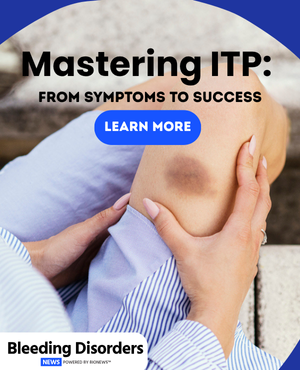
IVIG for immune thrombocytopenia
Last updated July 16, 2025, by Lindsey Shapiro, PhD

What is IVIG?
Intravenous immunoglobulin (IVIG) is an antibody-based therapy for immune thrombocytopenia (ITP) that has been used for more than 40 years. It’s administered directly into a vein (intravenously), allowing the treatment to enter the bloodstream and rapidly exert a therapeutic effect.
In ITP, the immune system mistakenly targets and destroys platelets, the circulating cell fragments that help with blood clotting. This makes patients more susceptible to easy or excessive bleeding. Such attacks typically are driven by antibodies that bind to platelets and mark them for destruction by immune cells called macrophages, especially in the spleen.
The ITP treatment IVIG is mainly composed of a class of naturally occurring antibodies known as immunoglobulin G (IgG). These antibodies are collected from the blood of thousands of healthy donors — from 1,000 to 100,000 — and pooled together into a concentrated therapeutic product.
Although the precise mechanism of IVIG for ITP is not fully understood, it is believed that the antibodies it contains bind to certain receptors on macrophages, essentially occupying them and interfering with their ability to target antibody-tagged platelets. This helps to prevent platelet destruction and reduces the risk of bleeding.
One of the key benefits of IVIG for ITP is that it can rapidly increase platelet levels, making it especially useful in urgent situations when platelet counts are dangerously low or significant bleeding is already occurring. It is also considered relatively safe, and may have fewer side effects than some other first-line treatment options.
When is IVIG used for immune thrombocytopenia?
IVIG is considered a first-line treatment for ITP, especially in situations where there’s a need to quickly raise platelet levels. It may be used alone or alongside other treatments.
Situations when IVIG may be recommended include:
- cases of severe ITP with a high risk of bleeding
- when significant bleeding is already occurring
- when needed to increase platelet levels before surgery or other invasive procedures
- if corticosteroids, another first-line treatment, are ineffective or cannot be used.
IVIG can be used in both children and adults with similar efficacy and side effect profiles.
A number of different IVIG products are approved for treating ITP. Among them are:
- Carimune NF
- Flebogamma DIF
- Gammaked
- Gammaplex
- Gamunex-C
- Octagam
- Panzyga
- Privigen.
IVIG therapy for ITP is administered via intravenous infusions by a healthcare provider. Infusions may last several hours, depending on the product and dose.
It’s typically given as a short-course therapy, either at a higher dose for 1-2 days, or at a lower dose over as long as five days. The exact dose of IVIG for ITP is determined based on the specific product used, as well as individual factors such as disease severity and a person’s risk of side effects.
Approximately 70%-80% of ITP patients respond to IVIG therapy, with platelet levels usually rising within a few days. However, the effect is usually temporary. Platelets often begin to decline within days to a few weeks after IVIG administration, meaning that patients may need repeat IVIG doses or other therapies for long-term disease management.
IVIG side effects
The most common side effects of IVIG include:
- headache
- high blood pressure
- fever
- chills
- nausea or vomiting
- muscle aches or pains.
Most IVIG side effects are mild and can be minimized by decreasing the rate of infusion and staying well hydrated. A doctor might also recommend taking premedications such as acetaminophen or antihistamines before treatment to prevent side effects.
Less commonly, more serious side effects may occur with IVIG and ITP, including:
- aseptic meningitis, or inflammation of the protective membranes covering the brain and spinal cord
- hemolysis, or red blood cell destruction
- kidney dysfunction or failure
- blood clots
- severe allergic reactions.
While the risk of these complications is low, individuals receiving IVIG should be closely monitored throughout treatment to help detect and manage any adverse reactions early on.
Bleeding Disorders News is strictly a news and information website about the disease. It does not provide medical advice, diagnosis, or treatment. This content is not intended to be a substitute for professional medical advice, diagnosis, or treatment. Always seek the advice of your physician or other qualified health provider with any questions you may have regarding a medical condition. Never disregard professional medical advice or delay in seeking it because of something you have read on this website.
Recent Posts
- ITP treatment Doptelet may help prevent bone loss in osteoporosis
- Bleeding risk high soon after kidney transplant in VWD, hemophilia A
- Combined therapy aids recovery for woman with TTP and lupus
- An ITP diagnosis wasn’t the final word on my health setbacks
- Cell therapy QT-019B shows strong response rate in hard-to-treat ITP
Related articles
-

-
-

THROMBOTIC THROMBOCYTOPENIC PURPURA
NewsCombined therapy aids recovery for woman with TTP and lupus
-
-
-




